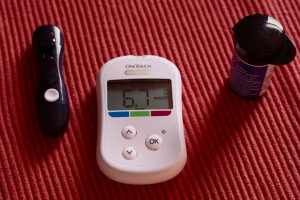Type 2 Diabetes and physical activity
Type 2 Diabetes: definition and symptoms 
The most common type of diabetes mellitus (type 2 diabetes, T2DM), is a disease which affects the blood sugar. The hormone insulin allows the glucose, which is an energy resource from the food, to go from the blood into the cells. When you have T2DM, your body does not produce or use insulin properly, and the glucose cannot be transferred well to the cells [1]. The result of this deficiency is an increased concentration of glucose in the blood, causing damage to the body’s systems, in particular the blood vessels and nerves [2]. A 2006 study showed that 3.8% of the Luxembourg population were treated with T2DM, but about 1.5% of the population were not aware of their disease [3]. Type 2 Diabetes increases with age. Some of the risk factors of T2DM can be tackled, such as overweight, physical inactivity and high blood pressure [4].
The effects of physical activity on Type 2 diabetes mellitus
Besides the well-known effect of physical activity in reducing the incidence of T2DM by 60% in people at risk [5], physical activity is one the three complementary treatments of T2DM, along with diet and medication. Among its plethora of benefits, aerobic physical activity (including also high-intensity interval training) improves the glycaemic control by increasing insulin sensitivity and decreasing insulin resistance and glycated haemoglobin type A1c (up to -0.6%) [6-8]. Physical activity improves local and systemic endothelial function and attenuates the capillary rarefaction in skeletal muscle associated with insulin resistance [9]. Among the general benefits on health of the resistance training, it improves glycaemic control in decreasing insulin resistance and glycated haemoglobin type A1c (from -0.3%) [10, 11]. Flexibility and balance exercises may reverse the T2DM-related limited joint mobility and can reduce the risk of falls, especially in the elderly people [12, 13]. Even if the evidence of the benefits of tai-chi on glycaemic control is still lacking [14], other alternative trainings, such as yoga, may be considered as they may have an impact on short-term glycaemic control [15].
What are the risks?
Beside the common risks of practicing a physical activity, a comprehensive list of physical activity precautions for patients with diabetes has been published by the American Diabetes Association (list available here: http://care.diabetesjournals.org/content/39/11/2065) [16]. Physical activity must be encouraged but adapted in Type 2 diabetes patients with cardiovascular diseases, nerve disease, eye diseases, kidney diseases and orthopaedic limitations.
Recommendations
The first recommendation is to reduce the time spent in daily sedentarily behaviour, like long lasting sitting positions, by bouts of standing or light intensity activities. 30 min of light activity already provides benefit on blood glucose. It is encouraged to increase both the total daily incidental physical activity (non-exercise) and structured exercises and incidental movements to modify insulin action in muscles and liver. Benefits will be observed with 150 minutes or more of moderate to vigorous aerobic activities per week (e.g. walking, running, dancing) [16]. This weekly physical activity has to be spread over three days at least and with no more than two consecutive days without training. In order to increase the benefit, these aerobic exercise sessions [17] can be combined with 60 minutes of resistance exercises (lifting weights) [18] spread over two non-consecutive days per week [16]. The best is to combine aerobic and resistance training of high intensity, because it involves a larger number of muscle fibres than moderate intensity exercise and thus improves microvascular functions and insulin sensitivity [9]. Therefore, exercise training program engaging the most skeletal muscle and the most skeletal fibres within each skeletal muscle during training sessions have to be preferred [9].
Related groups
References
- NIH: National Institute of Diabetes and Digestive and Kidney Diseases. Diabetes. 2017 [cited 2017 21/12/2017]; Available from: https://medlineplus.gov/diabetes.html.
- World Health Organization. Diabetes mellitus – Fact sheet N°138. 2017 [cited 2017 21/12/2017]; Available from: http://www.who.int/mediacentre/factsheets/fs138/en/.
- Renard LM, Bocquet V, Vidal-Trecan G, Lair M-L, Couffignal S, Blum-Boisgard C. An algorithm to identify patients with treated type 2 diabetes using medico-administrative data. BMC Medical Informatics and Decision Making 2011;11(1):23. Available at: https://www.ncbi.nlm.nih.gov/pmc/articles/PMC3090314/.
- Mayo Clinic. Diseases and Conditions: Diabetes. 2017 [cited 2017 21/12/2017]; Available from: https://www.mayoclinic.org/diseases-conditions/diabetes/basics/risk-factors/CON-20033091.
- Knowler WC, Barrett-Connor E, Fowler SE, et al. Reduction in the incidence of type 2 diabetes with lifestyle intervention or metformin. N Engl J Med 2002;346(6):393-403. Available at: http://www.nejm.org/doi/full/10.1056/NEJMoa012512#t=article.
- Snowling NJ, Hopkins WG. Effects of different modes of exercise training on glucose control and risk factors for complications in type 2 diabetic patients: a meta-analysis. Diabetes Care 2006;29(11):2518-27. Available at: http://care.diabetesjournals.org/content/29/11/2518.long.
- Stoa EM, Meling S, Nyhus LK, et al. High-intensity aerobic interval training improves aerobic fitness and HbA1c among persons diagnosed with type 2 diabetes. Eur J Appl Physiol 2017;117(3):455-467. Available at: http://dx.doi.org/10.1007/s00421-017-3540-1.
- Jelleyman C, Yates T, O’Donovan G, et al. The effects of high-intensity interval training on glucose regulation and insulin resistance: a meta-analysis. Obes Rev 2015;16(11):942-61. Available at: http://dx.doi.org/10.1111/obr.12317.
- Laughlin MH. Physical activity-induced remodeling of vasculature in skeletal muscle: role in treatment of type 2 diabetes. J Appl Physiol (1985) 2016;120(1):1-16. Available at: http://dx.doi.org/10.1152/japplphysiol.00789.2015.
- Gordon BA, Benson AC, Bird SR,Fraser SF. Resistance training improves metabolic health in type 2 diabetes: a systematic review. Diabetes Res Clin Pract 2009;83(2):157-75. Available at: http://dx.doi.org/10.1016/j.diabres.2008.11.024.
- Irvine C,Taylor NF. Progressive resistance exercise improves glycaemic control in people with type 2 diabetes mellitus: a systematic review. Aust J Physiother 2009;55(4):237-46. Available at: http://dx.doi.org/10.1016/S0004-9514(09)70003-0.
- Herriott MT, Colberg SR, Parson HK, Nunnold T,Vinik AI. Effects of 8 weeks of flexibility and resistance training in older adults with type 2 diabetes. Diabetes Care 2004;27(12):2988-9. Available at: http://dx.doi.org/10.2337/diacare.27.12.2988.
- Morrison S, Colberg SR, Mariano M, Parson HK,Vinik AI. Balance training reduces falls risk in older individuals with type 2 diabetes. Diabetes Care 2010;33(4):748-50. Available at: http://dx.doi.org/10.2337/dc09-1699.
- Lee MS, Jun JH, Lim H-J,Lim H-S. A systematic review and meta-analysis of tai chi for treating type 2 diabetes. Maturitas 2015;80(1):14-23. Available at: http://dx.doi.org/10.1016/j.maturitas.2014.09.008.
- Vizcaino M,Stover E. The effect of yoga practice on glycemic control and other health parameters in Type 2 diabetes mellitus patients: A systematic review and meta-analysis. Complementary Therapies in Medicine 2016;28(Supplement C):57-66. Available at: http://dx.doi.org/10.1016/j.ctim.2016.06.007.
- Colberg SR, Sigal RJ, Yardley JE, et al. Physical Activity/Exercise and Diabetes: A Position Statement of the American Diabetes Association. Diabetes Care 2016;39(11):2065-2079. Available at: http://dx.doi.org/10.2337/dc16-1728.
- Pedersen BK,Saltin B. Exercise as medicine – evidence for prescribing exercise as therapy in 26 different chronic diseases. Scand J Med Sci Sports 2015;25 Suppl 3:1-72. Available at: http://dx.doi.org/10.1111/sms.12581.
- Exercise is Medecine Australia. Exercise is Medecine Australia Factsheet: Type 2 Diabetes and exercise. 2014 [cited 2017 21/12/2017]; Available from: http://exerciseismedicine.com.au/wp-content/uploads/2016/11/2014-T2DM-FULL-v2.pdf.
Authors & expert
Authors : Alexis Lion1, Julia Ledien2.
Expert : Marc Keipes3.
1 Luxembourg Institute of Health, Sports Medicine Research Laboratory, L-1460 Luxembourg, Luxembourg
2 Luxembourg Institute of Health, Epidemiology and Public Health Research Unit, L-1445 Strassen, Luxembourg
3 Hôpitaux Robert Schuman, Zithaklinik, L-2763 Luxembourg, Luxembourg
Year of publication
2018
